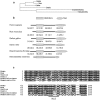Genome-wide identification of calcium-response factor (CaRF) binding sites predicts a role in regulation of neuronal signaling pathways
- PMID: 20523734
- PMCID: PMC2877716
- DOI: 10.1371/journal.pone.0010870
Genome-wide identification of calcium-response factor (CaRF) binding sites predicts a role in regulation of neuronal signaling pathways
Abstract
Calcium-Response Factor (CaRF) was first identified as a transcription factor based on its affinity for a neuronal-selective calcium-response element (CaRE1) in the gene encoding Brain-Derived Neurotrophic Factor (BDNF). However, because CaRF shares no homology with other transcription factors, its properties and gene targets have remained unknown. Here we show that the DNA binding domain of CaRF has been highly conserved across evolution and that CaRF binds DNA directly in a sequence-specific manner in the absence of other eukaryotic cofactors. Using a binding site selection screen we identify a high-affinity consensus CaRF response element (cCaRE) that shares significant homology with the CaRE1 element of Bdnf. In a genome-wide chromatin immunoprecipitation analysis (ChIP-Seq), we identified 176 sites of CaRF-specific binding (peaks) in neuronal genomic DNA. 128 of these peaks are within 10kB of an annotated gene, and 60 are within 1kB of an annotated transcriptional start site. At least 138 of the CaRF peaks contain a common 10-bp motif with strong statistical similarity to the cCaRE, and we provide evidence predicting that CaRF can bind independently to at least 64.5% of these motifs in vitro. Analysis of this set of putative CaRF targets suggests the enrichment of genes that regulate intracellular signaling cascades. Finally we demonstrate that expression of a subset of these target genes is altered in the cortex of Carf knockout (KO) mice. Together these data strongly support the characterization of CaRF as a unique transcription factor and provide the first insight into the program of CaRF-regulated transcription in neurons.
Conflict of interest statement
Figures







Similar articles
-
Biological functions and transcriptional targets of CaRF in neurons.Cell Calcium. 2011 May;49(5):290-5. doi: 10.1016/j.ceca.2011.04.003. Epub 2011 May 11. Cell Calcium. 2011. PMID: 21565403 Free PMC article. Review.
-
The transcription factor calcium-response factor limits NMDA receptor-dependent transcription in the developing brain.J Neurochem. 2016 Apr;137(2):164-76. doi: 10.1111/jnc.13556. Epub 2016 Feb 15. J Neurochem. 2016. PMID: 26826701 Free PMC article.
-
A calcium-responsive transcription factor, CaRF, that regulates neuronal activity-dependent expression of BDNF.Neuron. 2002 Jan 31;33(3):383-95. doi: 10.1016/s0896-6273(01)00561-x. Neuron. 2002. PMID: 11832226
-
Reduced cortical BDNF expression and aberrant memory in Carf knock-out mice.J Neurosci. 2010 Jun 2;30(22):7453-65. doi: 10.1523/JNEUROSCI.3997-09.2010. J Neurosci. 2010. PMID: 20519520 Free PMC article.
-
Insights from genomic profiling of transcription factors.Nat Rev Genet. 2009 Sep;10(9):605-16. doi: 10.1038/nrg2636. Epub 2009 Aug 11. Nat Rev Genet. 2009. PMID: 19668247 Free PMC article. Review.
Cited by
-
Biological functions and transcriptional targets of CaRF in neurons.Cell Calcium. 2011 May;49(5):290-5. doi: 10.1016/j.ceca.2011.04.003. Epub 2011 May 11. Cell Calcium. 2011. PMID: 21565403 Free PMC article. Review.
-
Expression analysis of prestin and selected transcription factors in newborn rats.Cell Mol Neurobiol. 2011 Oct;31(7):1089-101. doi: 10.1007/s10571-011-9708-z. Epub 2011 May 26. Cell Mol Neurobiol. 2011. PMID: 21614551 Free PMC article.
-
Mechanisms of specificity in neuronal activity-regulated gene transcription.Prog Neurobiol. 2011 Aug;94(3):259-95. doi: 10.1016/j.pneurobio.2011.05.003. Epub 2011 May 18. Prog Neurobiol. 2011. PMID: 21620929 Free PMC article. Review.
-
Core and region-enriched networks of behaviorally regulated genes and the singing genome.Science. 2014 Dec 12;346(6215):1256780. doi: 10.1126/science.1256780. Science. 2014. PMID: 25504732 Free PMC article.
-
Identification of Plagl1/Zac1 binding sites and target genes establishes its role in the regulation of extracellular matrix genes and the imprinted gene network.Nucleic Acids Res. 2017 Oct 13;45(18):10466-10480. doi: 10.1093/nar/gkx672. Nucleic Acids Res. 2017. PMID: 28985358 Free PMC article.
References
-
- Vaquerizas JM, Kummerfeld SK, Teichmann SA, Luscombe NM. A census of human transcription factors: function, expression and evolution. Nat Rev Genet. 2009;10:252–263. - PubMed
-
- Ross SE, Greenberg ME, Stiles CD. Basic helix-loop-helix factors in cortical development. Neuron. 2003;39:13–25. - PubMed
-
- Levine M, Tjian R. Transcription regulation and animal diversity. Nature. 2003;424:147–151. - PubMed
Publication types
MeSH terms
Substances
Grants and funding
LinkOut - more resources
Full Text Sources
Research Materials

